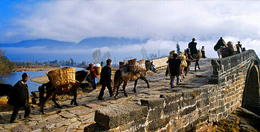Various Vintages Give Pu'er A Changing Character
It has often occurred to me that pu'er tea can be compared to wine. The green yellowish color of raw pu'er soup always reminds me of Chardonnay. The reddish-brown color of a matured pu'er can be compared to that of an aged Merlot, although mature pu'er is often even darker. And like wines, a vintage pu'er is both collectible and expensive.
Pu'er is a big-leaf tea produced in Yunnan, especially in the Lincang, Simao and Xishuangbanna areas. Written records of pu'er first appeared in the Ming Dynasty (1368-1644). The tea is commonly packaged as a cake, brick or lump, for convenient storage and transportation.
Among Chinese teas, an ordinary pu'er is probably the best value for money. A 100-gram round lump of ordinary pu'er can cost as little as 10 yuan ($1.5) on Taobao.com. The taste is delightful and the tea usually lasts longer than the small-leaf teas from central and eastern China.
The low price is partly due to the scale of production in Yunnan. Last year the province produced 360,000 metric tons of tea, 129,000 tons of which were made into pu'er, according to statistics from the Department of Agriculture of Yunnan Province. The province's production volume ranked second in China last year, next only to Fujian.
Pu'er was granted protected place of origin status on July 1, 2009; which means only big-leaf teas produced in Yunnan can be called pu'er. Previously, Guangdong province was also a big producer.
The fresh green leaves produced in Yunnan are also made into a green tea called dianlyu and a black tea called dianhong. The major difference between Yunnan dianlyu and pu'er is that the fresh green leaves used to make pu'er are dried at low temperature (sundried), and then are steamed and pressed into cakes using molds.
There is a difference between raw pu'er cakes, which look yellowish-green, and matured pu'er cakes, which look reddish-brown. Raw pu'er cakes can go through natural fermentation and become very deep in color, but that takes a long time.
Because the matured pu'er is so popular for its comforting mellow taste, in 1973, Menghai Tea Factory and Kunming Tea Factory in Yunnan jointly researched a method to ferment pu'er at controlled high temperature and humidity. Most of the shoupu, matured pu'er cakes, we see today are made using this method.
Once made into a cake, previously as a way to make transportation and storage easy, the taste also becomes more concentrated than the loose tea it is made with. Raw pu'er has a typical green plum taste. Raw tea cakes from some special territories like Bingdao and Xigui present an exquisite orchid aroma. But after a few years of natural aging, the taste becomes mellower and rounder, and a matured aroma arises that resembles dried jujube, longan, ginseng, lotus and sometimes camphorwood. The color of the drink is a beautiful bright red.
The best pu'er teas are from ancient trees on high mountains. It is not uncommon for Yunnan tea farmers to harvest leaves from trees that are several hundred years old. In fact, the oldest tea tree in Yunnan is a 3,200-year-old tree in Fengqing, Lincang city.
The long fame of pu'er has to do with the Tea Horse Road, an ancient road established during the Song Dynasty (960-1279) to trade horses for tea between Han people in Sichuan, Shaanxi and Yunnan provinces and ethnic groups in Tibet. There are three major routes inside China, one of them starting from Simao in the Qing Dynasty (1644-1911), which changed its name to Pu'er in 2007.
Because of its apparently healthy benefits, pu'er has become popular nationwide. And Pu'er became popular in Hong Kong and Taiwan in the 1990s when writers praised the taste and fragrance of old pu'er, and people began to collect it, making the price soar. Then some collectors hired dealers to stock up on new teas and put their old teas up for auction, which further pushed up prices.
In 2007, people stopped buying, and in the following years, sales and prices both dropped. However, the production of pu'er has recovered.
Despite the price fluctuations for other pu'er, the prices for the best-quality pu'er from the high mountains and old trees have remained high. A kilo of loose tea from Bingdao, for example, costs more than 10,000 yuan.
But one can always find a good pu'er from a relatively mature tea tree, one that is more than 80 years old, at a good price, around 200 yuan for a cake of 357 grams.














